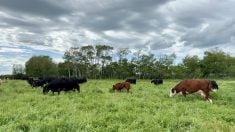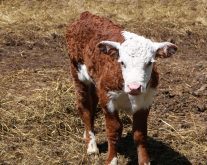In my last two columns (see links below), I have focused on how the cow prioritizes nutrient use for different physiological functions such as maintenance and pregnancy. This month I want to complete the discussion by focusing on the events leading up to and following calving.
- Read more: Feeding the pregnant beef cow
- Read more: Prioritizing nutrient use in pregnant and lactating cows
Read Also

What to know before you go to Agribition 2025
If you’re attending Agribition 2025, this is the place to find out about tickets, dates and what’s happening this year.
First let’s review a bit of lactation physiology that kicks in before calving. As you know, colostrum feeding within the first 12 hours of birth is critical to the passive transfer of maternal antibodies (i.e. immunoglobulins) to the newborn calf. These antibodies help the calf fight off disease challenges until its own immune system becomes fully functional. Colostrum formation is initiated before calving and stops shortly afterward. The value of colostrum depends on several factors, the most critical being the timing of feeding. Ideally, newborn calves receive five per cent of their body weight or approximately two litres of colostrum within the first four to six hours of life and another two litres within 12 hours. Timing is critical as the ability of the newborn’s intestinal wall to absorb these maternal antibodies ceases by 24 hours of life. This means that continued feeding will not result in any further enhancement of immune function.
Other factors influencing the value of colostrum to the calf include the volume produced and the concentration of critical immunoglobulins. Both are influenced by many factors including age, breed, milking ability and nutrition. Concerning nutrition, cows in good condition before calving will produce more colostrum, and thus an increased supply of immunoglobulins, than cows in poor body condition. This is one more reason to pay close attention to the pre-calving nutritional needs of your cows.
Following calving and the cessation of colostrum formation, the cow’s udder begins to secrete milk, which while lower in total solids is nutrient-dense, particularly in terms of fat, protein, minerals and vitamins. As with colostrum production, several factors influence the quantity and composition of milk produced. However, from the perspective of this column, post-partum nutrition is the most important. Requirements for several of the critical nutrients increase significantly relative to late gestation. For example, a 1,400-pound average milking cow, one to two months post-calving, requires approximately 20 per cent more net energy for maintenance/lactation than the same cow in the last month of pregnancy. Crude protein requirements increase by as much as 30 per cent.
Failure to provide a ration that is balanced to meet these requirements will result in loss of body condition and could lead to a drop in milk production, the consequences of which can affect current and future calf crops. For example, in herds where there is significant weight loss post-calving, it is not uncommon to see an increase in the time required for post-partum cows to return to breeding status. Further, once breeding begins, first-service conception rates are often reduced in these herds. Combined, the effect is a longer breeding and subsequent calving season and/or an increase in the number of open cows, all of which could affect the value of next year’s calf crop. If we look at the consequences on the current calf crop, if post-partum nutrition of the dam adversely affects her ability to produce milk, then there is a real possibility that weaning weights will be negatively affected come fall.
In addition to concerns about supplemental energy and protein, it is also necessary to pay attention to the post-partum supply of vitamins and minerals. Vitamin A requirements, for example, increase by 40 per cent with the onset of lactation. As colostrum/milk is the sole source of vitamin A for the newborn calf, meeting this requirement is critical for its health and development. A similar argument can be made for the macro minerals such as calcium, phosphorus and magnesium, all of which are required in increased amounts by the lactating cow.
Meeting trace mineral requirements is not only a function of supplying the appropriate quantity of the mineral in question but also taking steps to ensure that the form of the mineral fed is available to the animal. For example, comparing inorganic sources of copper, we know that copper oxide is very poorly absorbed relative to copper sulphate, which in turn has a lower availability than copper chloride. Chelated minerals are trace minerals such as zinc or copper that are bound to organic compounds such as protein or amino acids. These sources of trace minerals are highly available to the animal.
For feeding programs where there are no pre-existing conditions that hamper absorption, supplements formulated with inorganic forms of trace minerals such as copper sulphate or zinc oxide are sufficient to meet the animal’s requirements, particularly if there is a year-round feeding program in place. However, in situations where there are known antagonists with trace mineral absorption (i.e. high-sulphate water sources) or high productivity expected (i.e. embryo transfer programs), feeding the more available forms of the trace minerals can help ensure reproductive success.
If you are looking for an appropriate mineral/vitamin supplement to feed this spring, many feed companies offer a “breeder” mineral with enhanced levels of the macro and micro minerals as well as the fat-soluble vitamins (i.e. A, D and E). If these do not fit your situation, custom blends are available through your nutritionist.

















